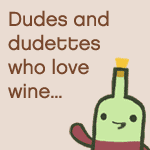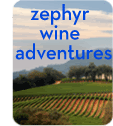 In this ultra-exciting edition of Tales of the Purple Monkey, Dude and Plumboo face off against a German Wine Label, as part of Wine Blogging Wednesday #45 (this month hosted over at the venerable Winecast.net).
In this ultra-exciting edition of Tales of the Purple Monkey, Dude and Plumboo face off against a German Wine Label, as part of Wine Blogging Wednesday #45 (this month hosted over at the venerable Winecast.net).
AND LIVE TO TELL THE TALE! WARNING: This post contains German words. Proceed with EXTREME CAUTION!!
WARNING: This post contains German words. Proceed with EXTREME CAUTION!!
To give you an appreciation of just how dangerous this mission was, we offer an excerpt regarding hunting the German Wine Label (GWL) from noted South African wildlife specialist Clive Walker's Signs of the Wild:
"One should always approach a GWL with great caution. They have poor eyesight and hearing, but have a keenly developed sense of smell. GWLs are normally nervous and will not hesitate to attack if they are disturbed, especially when young. When threatened, they will prominently display their Amtliche Prüfungsnummer, and Winzergenossenschaft, if present. GWLs are dangerous if wounded or when continuously pursued, hunted, or annoyed. An experienced wine geek may be able to drive off a GWL with appropriate knowledge of Germany's 13 Anbaugebiet, and while easily hunted it presents an extremely difficult target when charging head-on. Should you encounter a GWL, remain utterly still - under no circumstances run. One's inherent desire is to flee, but this carries with it the certainty of a permanent end to your days of fine German wine appreciating. There is no doubting the sheer terror that can run through one's veins when going up against a GWL. It can turn your blood ice-cold - which, in a pinch, you may be able to use to chill a white German wine to the appropriate serving temperature..."
Or something like that, anyway.

"The only real way to disarm a German wine label, and thus open yourself up to some seriously kickin' German wine experiences, is with a little bit of helpful knowledge."
Hyperbole aside, the labels on German wine bottles can be one of the most intimidating encounters for any budding wine shopper. Which is one of the main contributing factors to the tough times that German wines have in the American market; the other is that they are primarily made from grapes that are not household names to most American consumers. Which is a shame, because German wines can TOTALLY ROCK.
The GWL will try to intimidate and frighten you with its cacophony of German words and wine regulations. The only real way to disarm a German wine label, and thus open yourself up to some seriously kickin' German wine experiences, is with a little bit of helpful knowledge...
The fist and most important point to remember is this: ignore the craziness and focus on the areas where the GWL is most vulnerable:
- Who - the Producer, which is usually easy to find and often displayed prominently on the GWL.
- When - the Vintage year, very easy to ID.
 What - the Grape & Ripeness level. Germany makes wine from several tasty varietals, but by far its most noble grape is the aromatic, long-lived and refreshingly-acidic Riesling (the focus of today's adventure). Germany is cold. Because it's cold, it's not always easy to get grapes to ripen to acceptable wine-worthy levels; therefore, Germany has developed a series of quality tiers that roughly correspond to the ripeness of the grapes.
What - the Grape & Ripeness level. Germany makes wine from several tasty varietals, but by far its most noble grape is the aromatic, long-lived and refreshingly-acidic Riesling (the focus of today's adventure). Germany is cold. Because it's cold, it's not always easy to get grapes to ripen to acceptable wine-worthy levels; therefore, Germany has developed a series of quality tiers that roughly correspond to the ripeness of the grapes.
This is where things get a bit tricky. You can see from the adjacent pyramid (courtesy of GermanWineEstates.com) that it's not easy territory to navigate. The thing to remember is that the higher the ripeness level, the more likely it is that the wine is sweeter. This runs a pretty large gamut, from the tasteful and usually dry Kabinett to the ultra-rich Trockenbeerenauslese, which practically needs to be enjoyed with a spoon (or poured over waffles).- Where - the Region. Again, potentially tricky territory (ha-ha) here. If you stick with the major quality wine-growing regions (of which there are only 13) and avoid trying to sort out the sub-regions and individual vineyards (of which there are a boatload, some of which confusingly have the exact same names at different geographic levels), then you can navigate a GWL without too much pain.
Germany's 13 major winemaking regions have wines with identifiable personalities and styles. For example, Riesling from the Mosel-Saar-Ruwer is steely and lighter-bodied, while wines made from the same grape in the Rheingau are known for their spiciness and heavier richness.
"With a little practice, you can fell the beast that is the GWL and be on your way to enjoying some of the finest wine made on the planet."
An example of this in action can be seen in the following action photo of Plumboo with his felled prey, a 2003 Dr. Fischer Riesling Auslese from the Mosel-Saar-Ruwer region:

Not too painful, right? With a little practice, you can fell the beast that is the GWL and be on your way to enjoying some of the finest wine made on the planet. Hey, if a plush monkey with a squeak-toy for a head can do it, so can you.
Now, how does a wine like this taste, anyway? Here's the review that Plumboo and I came up with after our sampling of the Dr. Fischer:
Aromas of flowers, citrus, and wet rock, presented in an elegant way (maybe even a tad understated). A palate that is well put-together, integrating a light body with citrus fruit and a healthy amount of sweetness. If there's one element of the wine that's not yet in sync with the others, it's the bracing acidity - but give it 2 or 3 more years in the bottle, and it should come together quite nicely.
Now, sally forth and get thyself some German goodness. And don't let those GWLs scare you!
Cheers!
(images: gapingvoid.com, germanwineestates.com, livinghistoryfarm.org)



























2 comments:
Great post; thanks for participating again this time.
Cheers,
--
Tim Elliott
Winecast
Cool! Thanks!
Post a Comment